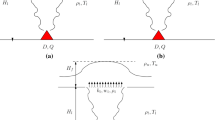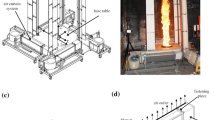Abstract
In recent years, significant progress has been made in the development of maritime facilities such as floating storage and regasification units. In such offshore environments, the change in fire source position owing to temporal oscillation associated with maritime facilities affects fire plume properties. Because the properties of fire plumes in maritime facilities are important when dealing with problems related to fire detection, smoke filling, etc., we have focused attention on fire plume properties above a reciprocating fire source in an unconfined space as a first step. In particular, we experimentally investigated the characteristics of temperature rise and upward velocity along the fire plume axis formed above a 0.1 m square diffusion burner, which harmonically oscillates so as to simulate ship rolling motion under the condition of a small rolling angle. To clarify the time-averaged properties of such fire plumes, the temperature rise and upward velocity up to 5.8 m from the burner surface have been measured by varying the amplitude in three steps (0.1 m, 0.2 m, and 0.3 m) and the period in four steps (6 s, 8 s, 12 s, and 18 s). The results show that the time-averaged temperature rise and upward velocity changes from a two-dimensional plume to an axisymmetric plume. Such transition heights were determined from a simple theoretical model for predicting plume properties above a harmonically oscillating fire source. In addition, empirical correlations for effective heat release rates were also developed. These correlations allowed the existing engineering relationships for temperature rise and upward velocity along the plume axis formed above a fixed-point fire source to be utilised in order to estimate the characteristic properties of a plume formed over a harmonically oscillating fire source. This engineering knowledge can be useful for developing elemental models for the development of a two-layer zone model for ship fires.















Similar content being viewed by others
References
Heskestad G (1984) Engineering relations for fire plumes. Fire Saf J 7:25–32. https://doi.org/10.1016/0379-7112(84)90005-5
Heskestad G (2008) Fire plume, flame height, and air entrainment, Chap 2-1, 2-1-2-20. In: The SFPE handbook of fire protection and engineering, 4th edn. National Fire Protection Association
Karlson B, Quintiere JG (2000) Fire plumes and flame height, enclosure fire dynamics. CRC Press, Boca Raton
Oka H, Oka Y (2013) Numerical investigation of fire plume properties under harmonically oscillating conditions. In: Proceedings on Asia Pacific symposium on safety, P2-09. https://doi.org/10.11345/nctam.61.57
Oka H, Oka Y (2013) Numerical simulation of a turbulent buoyant plume originating at an oscillating fire source. Theor Appl Mech Jpn 61:57–70. https://doi.org/10.11345/nctam.61.57
Oka H, Oka Y (2017) Numerical analysis on fire plumes formed above a harmonically oscillating flame source. Fire Saf J 88:56–66. https://doi.org/10.1016/j.firesaf.2016.12.001
Oka Y, Oka H, Iizuka M (2017) Plume temperature property formed above a horizontally oscillating fire source. Bull Jpn Assoc Fire Sci Eng 67(1):1–8 (in Japanese)
Heskestad G (1983) Virtual origin of fire plumes. Fire Saf J 5:109–114. https://doi.org/10.1016/0379-7112(83)90003-6
Tewarson A (2008) Generation of heat and gaseous, liquid, and solid products in fires, Chap 3-4, 3-109-3-194. In: The SFPE handbook of fire protection and engineering, 4th edn. National Fire Protection Association
McCaffrey BJ, Heskestad G (1976) A robust bidirectional low-velocity probe for flame and fire application. Combust Flame 26:125–127. https://doi.org/10.1016/0010-2180(76)90062-6
Yuan L, Cox G (1997) An experimental study of some line fires. Fire Saf J 27:123–139. https://doi.org/10.1016/s0379-7112(96)00047-1
Beyler CL (1986) Fire plumes and ceiling jets. Fire Saf J 11:53–75. https://doi.org/10.1016/0379-7112(86)90052-4
Hasemi Y, Nishihata M (1988) Fuel shape effect on the deterministic properties of turbulent diffusion flames. In: Proceedings on 2nd international symposium on fire safety science, hemisphere, New York, pp 275–284. https://doi.org/10.3801/iafss.fss.2-275.
Acknowledgements
This work was supported in part by JSPS KAKENHI, Grant No. JP26560174.
Author information
Authors and Affiliations
Corresponding author
Additional information
Publisher's Note
Springer Nature remains neutral with regard to jurisdictional claims in published maps and institutional affiliations.
Rights and permissions
About this article
Cite this article
Oka, Y., Oka, H. & Iizuka, M. Experimental Study of Fire Plume Above a Fire Source with Simple Harmonic Oscillation in Horizontal Direction. Fire Technol 55, 875–902 (2019). https://doi.org/10.1007/s10694-018-0808-x
Received:
Accepted:
Published:
Issue Date:
DOI: https://doi.org/10.1007/s10694-018-0808-x




